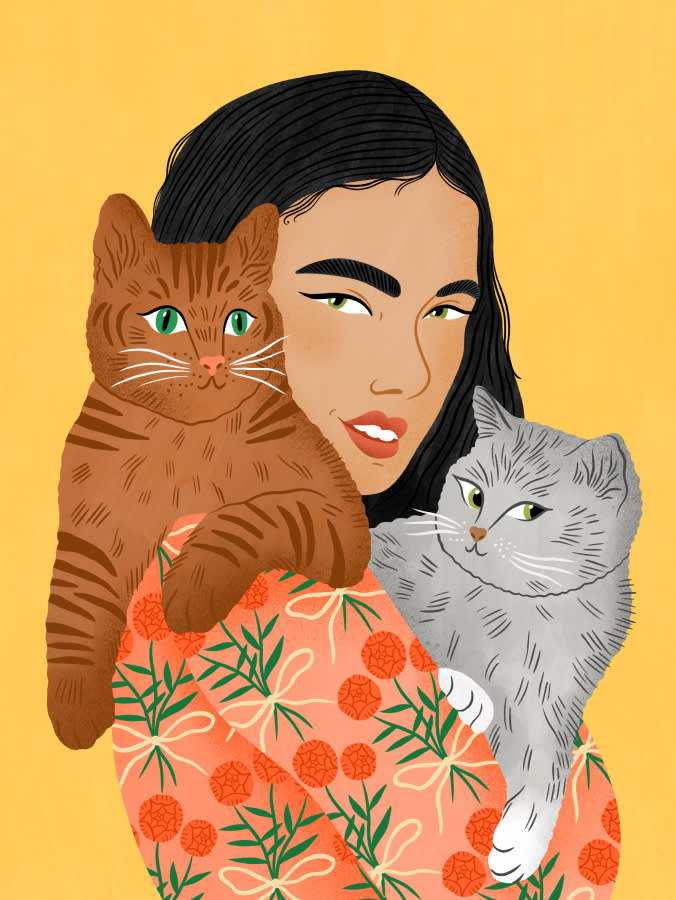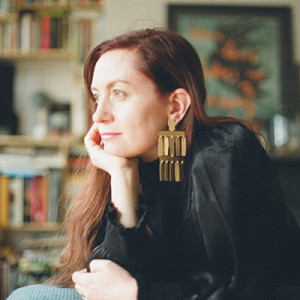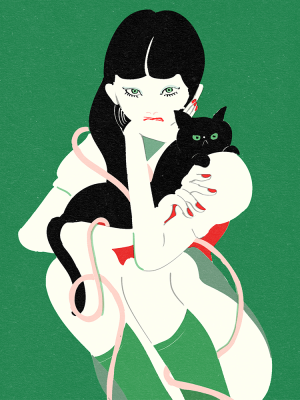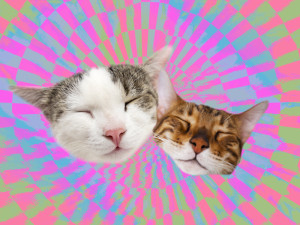The Story Behind the Iconic Cat Eye
This feline-inspired makeup trend continues to reign supreme

share article
Elizabeth Taylor was one of a kind, but one of her signature looks was influenced by an animal just as iconic as her legacy: the cat.
Here’s the story behind the makeup trend with as much staying power as the classic Hollywood star – and those who followed in her footsteps.
There’s a lesser-known Taylor movie from 1974 called The Driver’s Seat. Based on a metaphysical novellaopens in a new tab by the great Muriel Spark, it features a cameo by Andy Warhol as a British nobleman and stars Taylor as a woman teetering dangerously on the edge. This sounds like a recipe for cinematic greatness, but despite all that, the film was reportedly met by silence during its premiere at Cannes and was mostly ignored by critics.
Since then, thankfully, like so much else, it has since been embraced by a certain subsetopens in a new tab of film and fashion fans who appreciate its deranged glamour and absurd dialogue. Beauty hobbyists and professionals have happened upon the movie for another reason: a minute-long scene of Taylor carefully applying her eye makeup in a bathroom mirror, layering shadow and rimming kohl around those famous violet eyes.
Taylor was actually known for being quite adept at doing her own makeupopens in a new tab. In fact, she painted her own faceopens in a new tab for what is widely considered her most famous makeup role: the titular Cleopatra in the epic 1963 filmopens in a new tab. The make-up artist for the film, Alberto De Rossi, had a serious injury, so Taylor was left to take inspiration from his sketches and wing it. Her makeup handiwork would produce one of the most referenced cat eyes of all time.
The extended feline-like flick that has come to be known as the cat eye is many centuries old, believed to have originated in ancient Egypt where it was favoured by men and women alike – including famous ones like Cleopatra and Nefertiti. Thought to be a sartorial form of protection against the ‘evil eye’, the cat eye was back then achieved with minerals like malachite and copper ore, per opens in a new tab.
When the look experienced a resurgence in the 1920s, it was stoked perhaps in part by the 1917 big screen version of Cleopatra starring silent film actress Theda Bara, and the incandescent Josephine Baker, who often sported a cat eye on stage. Women then often relied on a blend of Vaseline and soot to create their cat eyes, Richard Corson details inFashions in Makeup: From Ancient to Modern Timesopens in a new tab.
When the look was picked up again in the 1960s by titans of glamour such as Taylor, Sophia Loren, Maria Callas, Barbra Streisand and Brigitte Bardot, application had become somewhat easier thanks to the invention of liquid lineropens in a new tab in the 1950s.
From then on, the cat eye would never fall out of fashion, though it would go through many incarnations and find some unlikely fans. Icons of the 1970s punk movement like Soo Catwoman and Siouxsie Sioux literally pushed the boundaries of the look, extending their line to cover the entire eye socket, and sometimes, as Soo did, filling it in with acid-green eyeshadow. Diane Lane’s turn as Corinne Burns in the cult 1982 punk rock filmLadies and Gentlemen, the Fabulous Stainsopens in a new tab included an exaggerated interpretation of the cat eye, complete with red flames extending above her brows.
Edie Sedgwick and Twiggy cat-eyed, pairing the look with major lashes, as did Diana Ross. It was part of how Elvira, Mistress of the Dark got into characteropens in a new tab; a densely underlined version is a longtime signature of visual artist Shirin Neshat; and singers from Ariana Grande to Adele and, most famously, Amy Winehouse, have made it a significant part of their look.
But as ubiquitous a look as it has become (posts tagged ‘cateye’ have 1.9 billion views on TikTok), creating it can feel daunting to many. A slender, brush-tipped pen is what New York-based makeup artist Suzy Gerstein recommends (this is her favouriteopens in a new tab) for ease of application and precision. “Lean the brush as close into the base of your lashes as you can get it,” says Suzy. “If you have shaky hands, keep your arms in close to your body and try steadying your elbow on a counter or table.”
For those who feel more confident with a powder eyeshadow, Suzy likes the ones from Neenopens in a new tab for their smooth application and dense pigment. “Just dip an angled brush into some water or a waterproofing product like Inglot Duraline Makeup Mixing Liquidopens in a new tab and you have yourself a custom liquid liner,” says Suzy, adding that cotton buds and micellar water, like Bioderma Sensibio H2Oopens in a new tab, should be kept handy for perfecting your line.
Nowadays there are countless twists on the classic. Suzy loves a bright-coloured cat eye, a dual-coloured neon, and a cat eye with negative space. “A reverse cat eye works with many eye and face shapes too, and is nice when you have hooded or deep-set eyes with less real estate on top,” she explains.
Why the cat eye’s appeal has endured for centuries now is in part because of its infinite adaptability, says Suzy, and that it’s incredibly flattering. She adds: “It’s a powerful means of play, even self-expression.”

Fiorella Valdesolo
Fiorella Valdesolo is a writer, editor, brand and creative consultant. She’s worked with New York, Elle, The Wall Street Journal, T, Glamour, Vogue, Women's Health, Nylon, Style.comopens in a new tab, Net-a-Porter, and Domino, among others. She is the cofounder and editor-in-chief of the independent food magazine Gather Journal and the author of Pretty: The Nylon Book of Beauty. She lives in Brooklyn with her partner Nate and daughter Aluna. Her dream interview remains Stevie Nicks.
Related articles
![a woman with black hair, green eyes, and red nails hugs a black cat]() opens in a new tab
opens in a new tabBlack Cats: Good Luck Charms Or Bad Omens?
Let’s dispel some silly superstitions
![Extremely blissed out cats on a psychedelic background]() opens in a new tab
opens in a new tabHow Catnip Blisses Out Cats
I’m so high right meow
![a tattooed person with curly red hair on a couch pets a brown and black cat]() opens in a new tab
opens in a new tabCan Your Cat Smell If You’re Stressed?
And will they do anything about it if they do?
![person holding a cat surrounded by a cat shaped candle, cat portrait double tiered plate, and maroon cat bed]() opens in a new tab
opens in a new tabGifts For the Classy Cat People in Your Life
Because there’s nothing they love more than displaying their admiration for all things feline



